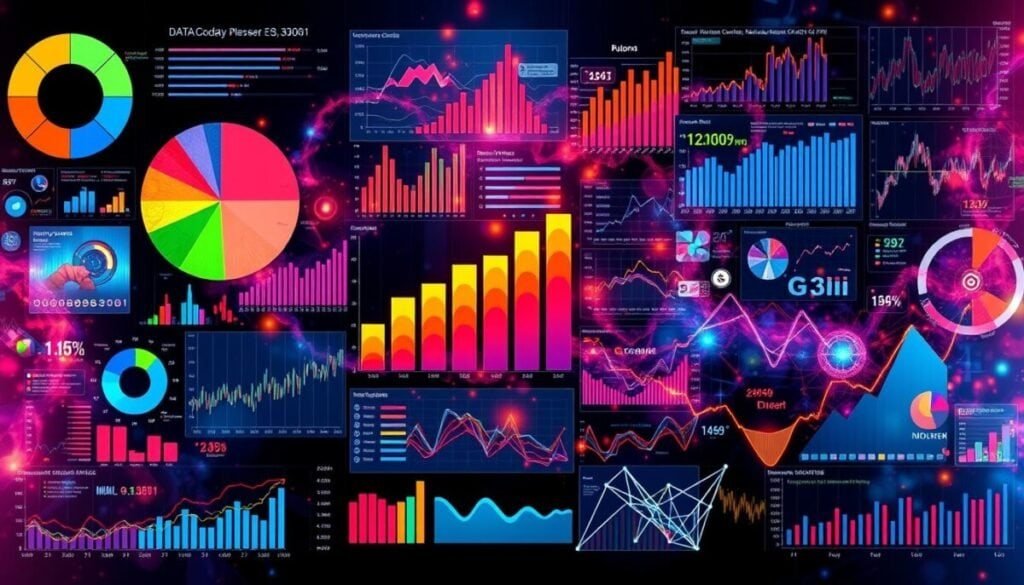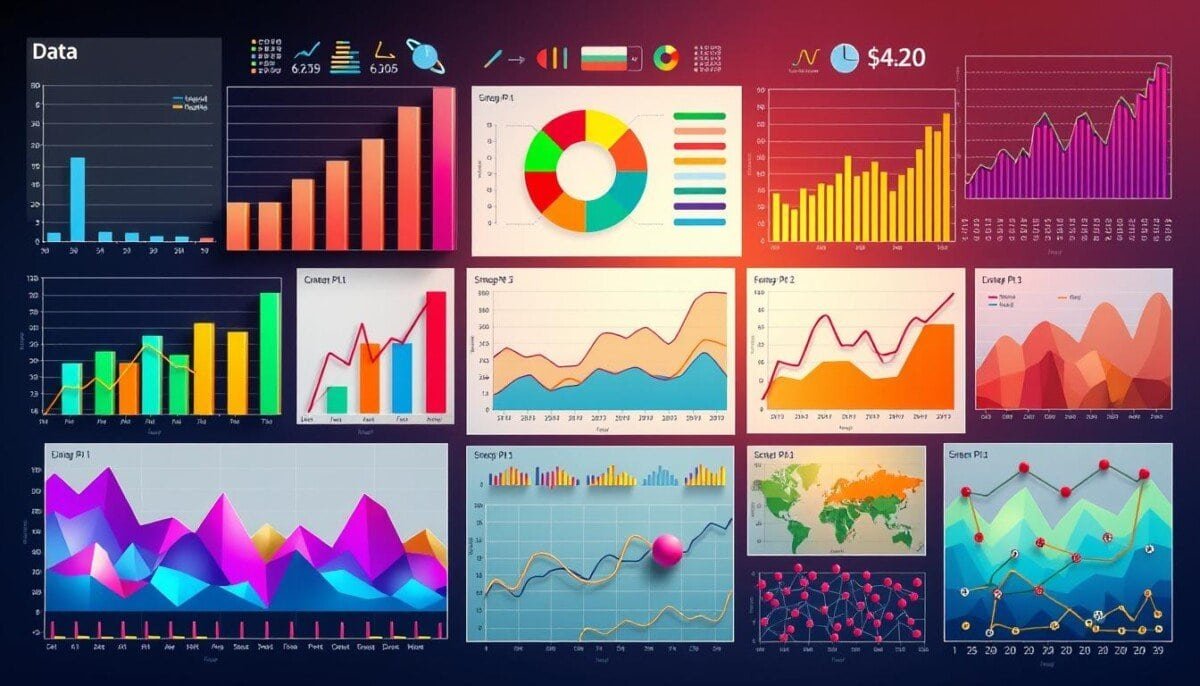Remember that moment when a room full of executives suddenly came to life? It happened when a simple click turned numbers into a vibrant chart. That’s the power of data visualization. It makes complex data easy to understand and exciting to explore.
Ever felt overwhelmed by too much data? Data visualization turns that chaos into clear insights. It’s not just about pretty pictures. It’s about telling stories with data and making it accessible to all.
In today’s world, being able to visualize data is key. Whether you’re in marketing or data science, knowing how to visualize data is crucial. It unlocks deep insights and helps you make informed decisions.
We’ll look at how tools like exploratory data analysis and visual analytics can turn data into stories. We’ll learn how to create visualizations that inform and inspire. Join me as we explore how to make data speak volumes without words.
Key Takeaways
- Data visualization transforms complex information into easily understandable formats
- Effective visualizations enable data-driven decision making across various fields
- Different types of charts and graphs serve specific purposes in data analysis
- Visual analytics tools enhance the exploration and interpretation of large datasets
- Data storytelling techniques create compelling narratives from raw information
- Mastering visualization techniques is essential for uncovering insights in the big data era
Understanding the Power of Data Visualization
Data visualization turns complex data into simple visuals. It’s vital in our data-rich world for clear information design and reporting. We’ll see how it helps make decisions and benefits businesses.
Defining Data Visualization and Its Importance
Data visualization is about showing data in pictures. It uses charts, graphs, and maps to share information. In data journalism, it tells stories in numbers. For example, line charts show trends, and maps show health data by area.
The Role of Visualization in Data-Driven Decision Making
Visualization is essential for smart decisions. It helps spot patterns and oddities quickly. Companies that use analytics well do better than others. Dashboards are key, making fast, data-driven choices easier.
Benefits of Effective Data Visualization for Businesses
Effective visualization brings many benefits:
- It makes data easy for everyone to understand
- It helps grasp complex info fast
- It spots trends and patterns quickly
- It engages stakeholders better
- It makes decision-making more efficient
| Visualization Type | Use Case | Benefit |
|---|---|---|
| Bar Charts | Comparing quantities | Easy category comparison |
| Heat Maps | Correlation tables | Quick pattern identification |
| Scatter Plots | Relationship between variables | Correlation visualization |
With U.S. digital ad spending set to hit $390 billion by 2027, businesses need strong data visualization tools. They help navigate the complex digital world and make smart marketing choices.
Fundamental Principles of Data Visualization Design

Data visualization is a powerful tool for sharing complex information. We’ll look at key principles for effective visual analytics and infographic creation. These principles help us make clear, engaging, and informative visuals that connect with our audience. By leveraging vector graphics design tools, creators can ensure their visuals remain sharp and scalable across various formats, enhancing their versatility. Thoughtful use of colors, typography, and layout further supports the clarity and impact of the message being conveyed. Ultimately, the combination of strong design principles and powerful tools allows data to tell a compelling and accessible story.
Simplicity is key in data visualization design. Keeping our visuals clean and simple lets the main message stand out. This makes it easier to understand and avoids overwhelming the viewer.
Choosing the right chart type is important. Different data sets need different visual representations. Let’s examine some common chart types and their uses:
| Chart Type | Best Used For |
|---|---|
| Bar Charts | Comparing categories |
| Line Graphs | Showing trends over time |
| Pie Charts | Displaying parts of a whole |
| Scatter Plots | Revealing relationships between variables |
Color is crucial in interactive visualization. Using color wisely can guide the viewer’s attention and improve understanding. It’s important to stick to a consistent color scheme that matches your brand and message.
Highlighting key information is vital in visual analytics. Use size, contrast, and position to highlight important data points. This helps viewers quickly understand the most important insights from your visualization.
Remember, the goal of data visualization is to make complex information easy to understand. By following these principles, we can create compelling visuals that effectively share our data stories.
Types of Data Visualization Techniques

Data visualization techniques help us understand complex information. We use different methods to make data easy to see and understand. Let’s look at some common types used in exploratory data analysis and information design.
Charts and Graphs
Bar charts are great for comparing different categories. Line charts show trends over time. Pie charts show how parts make up a whole. Scatter plots show how variables are related. These tools are the basics of data visualization.
Maps
Choropleth maps use color to show data across regions. Heat maps use color to show complex data. Geographic visualizations plot data on maps, making patterns clear.
Infographics and Dashboards
Infographics mix text, images, and charts to tell stories with data. Dashboards show important metrics all in one place, often updating live. Both are great for sharing data with many people.
Interactive and Dynamic Visualizations
Interactive visualizations let users explore data themselves. Dynamic visualizations change as new data arrives. These advanced tools engage viewers and uncover deeper insights.
| Visualization Type | Best Used For | Example |
|---|---|---|
| Bar Charts | Comparing categories | Sales by product |
| Line Charts | Showing trends over time | Stock prices |
| Pie Charts | Displaying parts of a whole | Budget allocation |
| Scatter Plots | Revealing relationships | Height vs. weight |
| Heat Maps | Visualizing complex data | Website click patterns |
Choosing the Right Visualization for Your Data
Choosing the right visualization is crucial for effective data storytelling. We must match our data types with the right visual representations. This way, we create impactful dashboard designs. Let’s explore how to make the best choices for our visual analytics.
Matching data types to appropriate visualizations
Different data types need specific visualization techniques. For part-to-whole relationships, pie charts and donut charts are great. Bar charts are best for comparing values between groups. Line charts are perfect for time-series data.
Scatter plots are excellent for showing relationships between variables. By pairing data types with their ideal visual counterparts, we improve our ability to communicate insights effectively.
Considering audience and context
Our audience’s familiarity with data and the context of presentation are key. For data-savvy viewers, we might choose more complex visuals like box plots or violin plots. For a general audience, simpler bar charts or line graphs are often better.
Remember, the goal is clear communication, not showing off technical skills.
Balancing complexity and clarity
While it’s tempting to include all data in one visualization, clarity is more important. Sometimes, a series of simple charts tells a better story than a complex one. We aim to balance showing the richness of our data and keeping it easy to understand.
This approach ensures our visual analytics serve their purpose: turning raw data into actionable insights.



